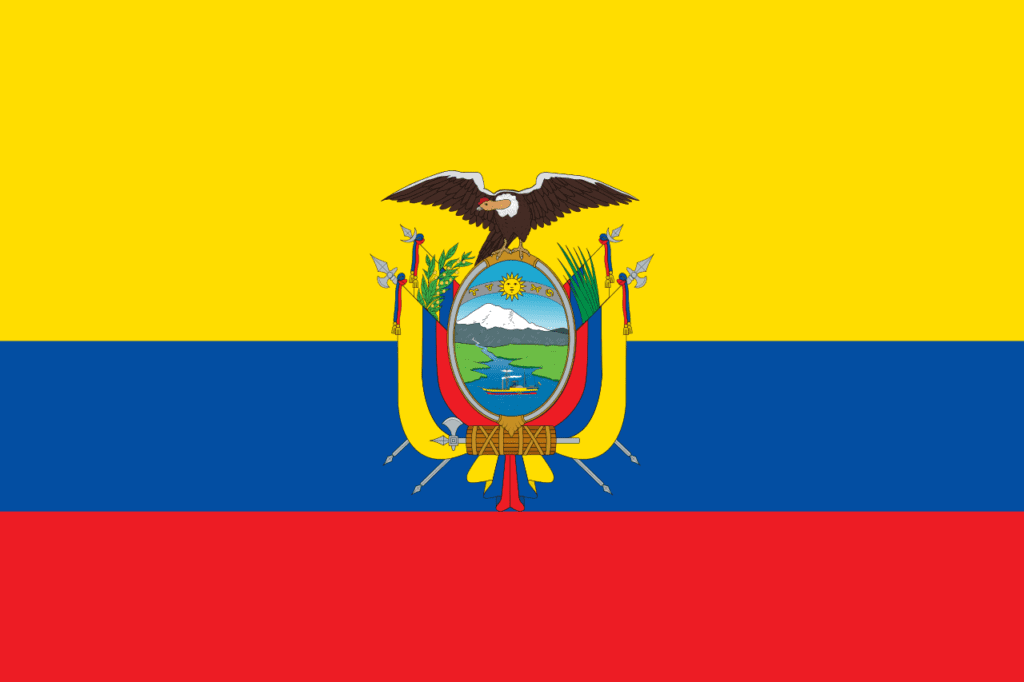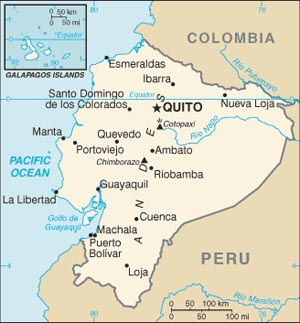Table of Contents
| Location and Size | Credit and Collections |
| Government | Risk Assessment |
| Legal System | Business Climate |
| People | Business Protocol |
| Economy | |
| Comparative Indicators |
12345
Location and Size
Ecuador is located in western South America, bordering the Pacific Ocean at the Equator, between Colombia and Peru. It’s land area is 276,841 sq. km., which is about the size of Colorado, and includes the Galapagos Islands.
Government
Ecuador’s government is a representative democratic republic with 24 provinces.
Branches:
- Executive: Chief of State and Head of Government – President Guillermo Lasso; Vice President Alfredo Borrero; cabinet appointed by the President
- Legislative: unicameral National Assembly including 124 seats with members elected through a party-list proportional representation system to serve 4 years
- Judicial: National Court of Justice; Constitutional Court
Legal System
Ecuador has a civil law legal system based on the Chilean civil code with modifications.
The country has not accepted compulsory International Court of Justice (ICJ) jurisdiction with reservations. It does accept International Criminal Court jurisdiction.
The Ecuadorian judicial system is inefficient and vulnerable to political interference. Court delays are significant, and judgments are inconsistent.
People
- Population: 17,483,326 (2023 est.)
- Population growth rate: 1.1% (2023)
- Languages: Spanish (Castilian) 93% (official), Quechua 4.1%, other indigenous 0.7%, foreign 2.2%; note – (Quechua and Shuar are official languages of intercultural relations; other indigenous languages are in official use by indigenous peoples in the areas they inhabit)
- Literacy: 94.48% (2023 est.)
- Ethnic Make-up: Mestizo (mixed Amerindian and White) 71.9%, Montubio 7.4%, Amerindian 7%, White 6.1%, Afroecuadorian 4.3%, Black 1%, other 2.3%(2023 est.)
- Religions: Roman Catholic 68.8%, Evangelical 15.4%, Adventist 1.2%, Jehovah’s Witness 1%, other 1.3%, agnostic or atheist 1.4%, none 10.1%, don’t know/no response 1% (2023 est.)
Economy
The Ecuadorean economy is very dependent on a limited number of commodities including oil, gold, copper, seafood, flowers, coffee, cocoa, and sugar, which represent 90% of Ecuador’s exports. It’s petroleum resources have accounted for more than half of the country’s export earnings and approximately two-fifths of public sector revenues in recent years.
Limited access to international financing forced the government to reduce expenditure levels and cover a budgetary financing gap with loans from international financial institutions, funds from Ecuador’s Social Security Institute, and financing from China.
Leading Markets (2023): US 45%, Peru 7.7%, Venezuela 6.5%, Colombia 4.6%, Panama 4.6%, Chile 4.2%
Leading Exports – Commodities: petroleum, bananas, cut flowers, shrimp, cacao, coffee, wood, fish
Leading Suppliers (2023): China 9.4%, Colombia 9.1%, Brazil 4.2%, Venezuela 3.9%
Leading Imports – Commodities: industrial materials, fuels and lubricants, non-durable consumer goods
Top Industries: petroleum, food processing, textiles, wood products, chemicals
Top Agricultural Products: bananas, coffee, cocoa, rice, potatoes, manioc (tapioca), plantains, sugarcane; cattle, sheep, pigs, beef, pork, dairy products; fish, shrimp; balsa wood
Comparative Economic Indicators – 2023
| Ecuador | Bolivia | Chile | Colombia | Peru | Venezuela | |
| Population* (millions) | 17.4 | 10.3 | 17.1 | 45.2 | 29.5 | 28.0 |
| Population growth rate (%) | 1.1 | 1.7 | 0.9 | 1.1 | 1.0 | 1.5 |
| Age Structure (%) (15 to 64 years old) |
68 | 60.7 | 68.1 | 67.2 | 65.1 | 65.1 |
| Age Structure (%) (65+ years old) |
6.8 | 4.6 | 9.6 | 6.1 | 6.4 | 5.4 |
| Literacy (%) | 94 | 86.7 | 95.7 | 90.4 | 95.9 | 93.0 |
| Unemployment rate (%) | 4.8 | 5.5 | 6.9 | 10.8 | 7.7 | 7.3 |
| Inflation (%) | 5.4 | 6.9 | 3.3 | 3.7 | 3.4 | 27.6 |
| Population below poverty line (%) | 28.6 | 51.3 | 11.5 | 37.2 | 31.3 | 27.4 |
| GDP** (USD billions) | 125.8 | 51.5 | 281.0 | 470.7 | 301.5 | 373.7 |
| GDP real growth rate (%) | 6.5 | 5.1 | 6.5 | 5.7 | 6.9 | 4.2 |
| GDP per capita** (USD) | 8,300.0 | 4,800.0 | 16,100.0 | 10,100.0 | 10,000.0 | 12,400.0 |
| Public debt (% of GDP) | 22.1 | 36.6 | 9.4 | 45.6 | 21.7 | 36.3 |
| Industrial production growth rate (%) | 1.9 | 3.6 | 5.3 | 4.9 | 5.6 | 1.4 |
| Exports (USD billions) | 22.3 | 9.1 | 86.1 | 56.5 | 46.3 | 92.6 |
| Imports (USD billions) | 23.6 | 7.6 | 72.3 | 54.7 | 37.0 | 46.4 |
| Currency | Dollar (USD) |
Boliviano (BOB) |
Peso (CLP) |
Peso (COP) |
Nuevo Sol ( PEN) |
Bolivar (VEB) |
| Exchange rates (per USD) 04/27/2023 | 1.0 | 6.9 | 487.5 | 1,762.7 | 2.6 | 4.3 |
| Exchange rates (per EUR) 04/27/2023 | 0.91 | 9.0 | 642.1 | 2,321.5 | 3.5 | 5.7 |
Economic Data from CIA World Factbook
Credit and Collections
Dispute Resolution
In Ecuador, civil courts are primarily divided by territory and hierarchy. Both divisions overlap at the third level of hierarchy, where there is only one national court for the whole country. Regarding that hierarchy, there is a first level of civil courts that handles all the cases from a specific territory within the province. At this level, only one judge manages each case.
Additionally, there is the court of appeals or provincial court, with one of each per province, except for provinces that do not handle many claims, such as the Galapagos Islands. In the court of appeals, three judges sit and handle each case, and a ruling is issued by majority vote. Similar to the first level, the number of judges varies by the amount of claims each province handles, with a minimum of three per case.
Risk Assessment
Coface Country Rating: C – Moderate risk.
Coface Business Climate Rating: B – Slight risk.
In 2023, the Ecuador economy is expected to fully fill the GDP gap triggered by the COVID-19 pandemic. Private consumption (roughly 62% of GDP) will remain the main driver of the economy amid a stable job market, and as consumer price pressures ease somewhat. Despite relevant fuel subsidies (estimated at 2.6% of GDP in 2022) and the fact that the economy is fully dollarised, domestic prices were not completely spared in 2022 by the sharp rise seen in international commodities.
Business Climate
Considerably undermining economic freedom, the reach of Ecuador’s government continues to expand to economic sectors beyond the petroleum industry. The rule of law is undermined by pervasive corruption that weakens property rights. The private sector is struggling to operate in what is now a restrictive entrepreneurial environment.
Economic Freedom (2023 Index of Economic Freedom): Ecuador’s economic freedom score is 55.0, making its economy the 119th freest in the 2023 Index. Ecuador is ranked 24th out of 32 countries in the South and Central America/ Caribbean region, and its overall score is far below world and regional averages. The government’s policy of continual expansion into economic sectors has considerably undermined economic freedom forcing the private sector to compete with a growing public sector in what has become a restrictive entrepreneurial environment.
Regulatory System: Ecuador’s regulatory system is not transparent. Government officials and private Ecuadorian businesses have used regulations and questionable legal maneuvers to affect foreign company operations. Some foreign companies have been required to make additional payments not negotiated in original agreements.
Intellectual Property Rights: There is a widespread local trade in pirated audio and video recordings, computer software, and counterfeit activity regarding brand name apparel in Ecuador. Enforcement against intellectual property infringement, which is the purview of the national police and the customs authority, has been ineffective.
Corruption: The rule of law in Ecuador is undermined by pervasive corruption. Illicit payments for official favors and thefts of public funds are common.
Political Violence: Ecuador does not have a tradition of substantial guerrilla activity, nor of frequent violence as a result of demonstrations or political instability. Crime, however, is a serious concern, especially in the larger cities. Violent crime has significantly increased over the last few years, with American citizens being victims of crimes, including homicides, armed assaults, robberies, sexual assaults, and home invasions.
Business Protocol
- Ecuadorians are more formal in their business dealings than many other cultures. Shake hands when meeting someone, also when leaving.
- Professional or academic titles with the surname are used in business. Common titles are “Doctor” (medical doctor or Ph.D.), “Ingeniero” (engineer), “Arquitecto” (architect), and “Abogado” (lawyer). If someone does not have a title, the honorific Senor or Senora is used with the surname. Always wait until invited before moving to a first-name basis.
- Business cards are exchanged during the initial introductions. Although most business executives speak English, it is a good idea to have one side of your business card translated into Spanish.
- The Ecuadorian culture is reliant on relationships, trust and non-verbal cues. Being distant or protective of personal information can, therefore, be construed as being rude.
- Ecuadorians are indirect communicators who speak diplomatically and with courtesy. They view blunt communication as extremely rude.
- Ecuadorians are essentially concerned with the people they are doing business with, not the company.
- Avoid confrontation and be careful not to embarrass people or publicly place them in awkward positions. Calling attention to someone’s error demonstrates a lack of finesse.
**********
Subscribe to the Credit-to-Cash Advisor
Monthly e-Newsletter — It’s Free
This information is provided by ABC-Amega Inc. Providing international receivable management and debt collection services for exporters to more than 200 countries. For further information, contact [email protected].

